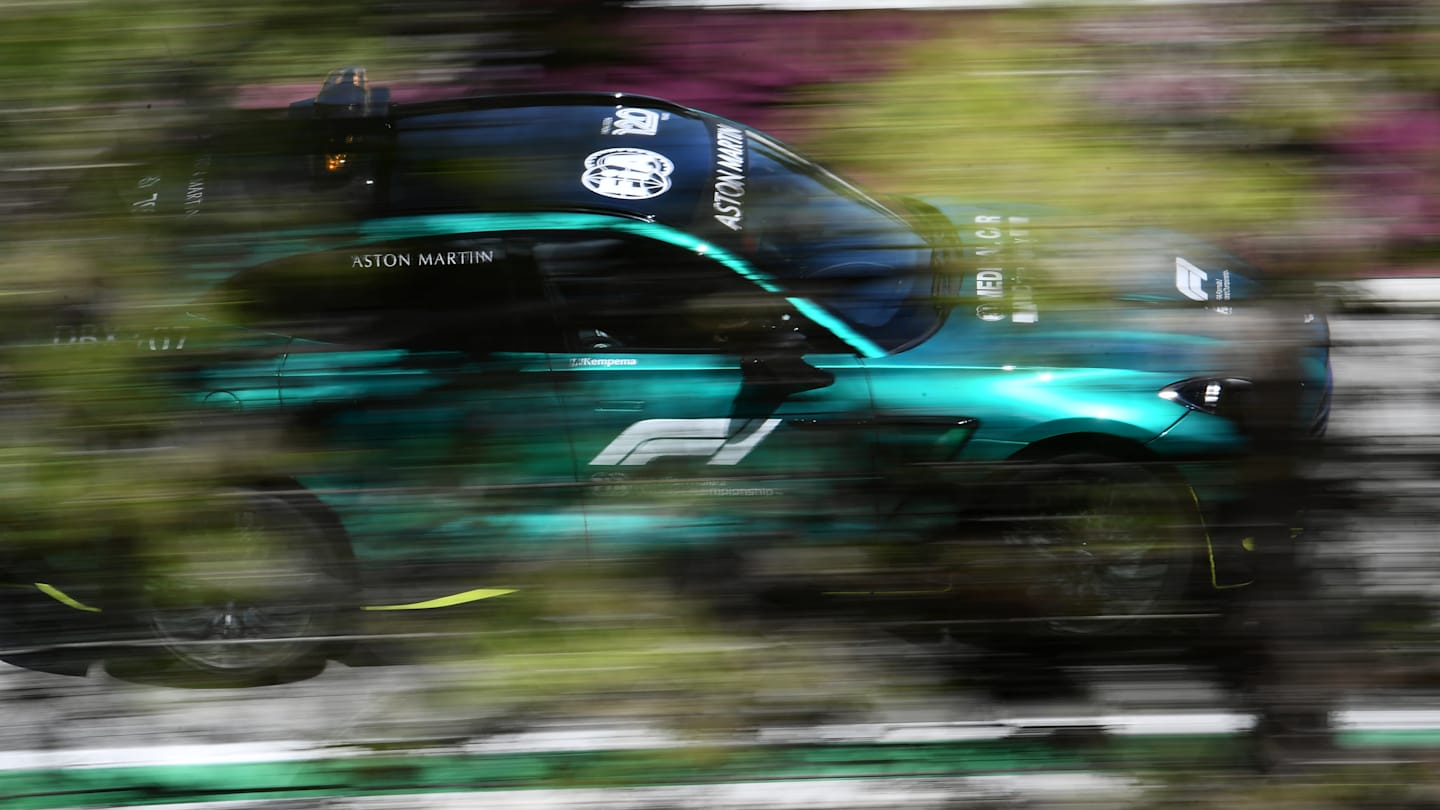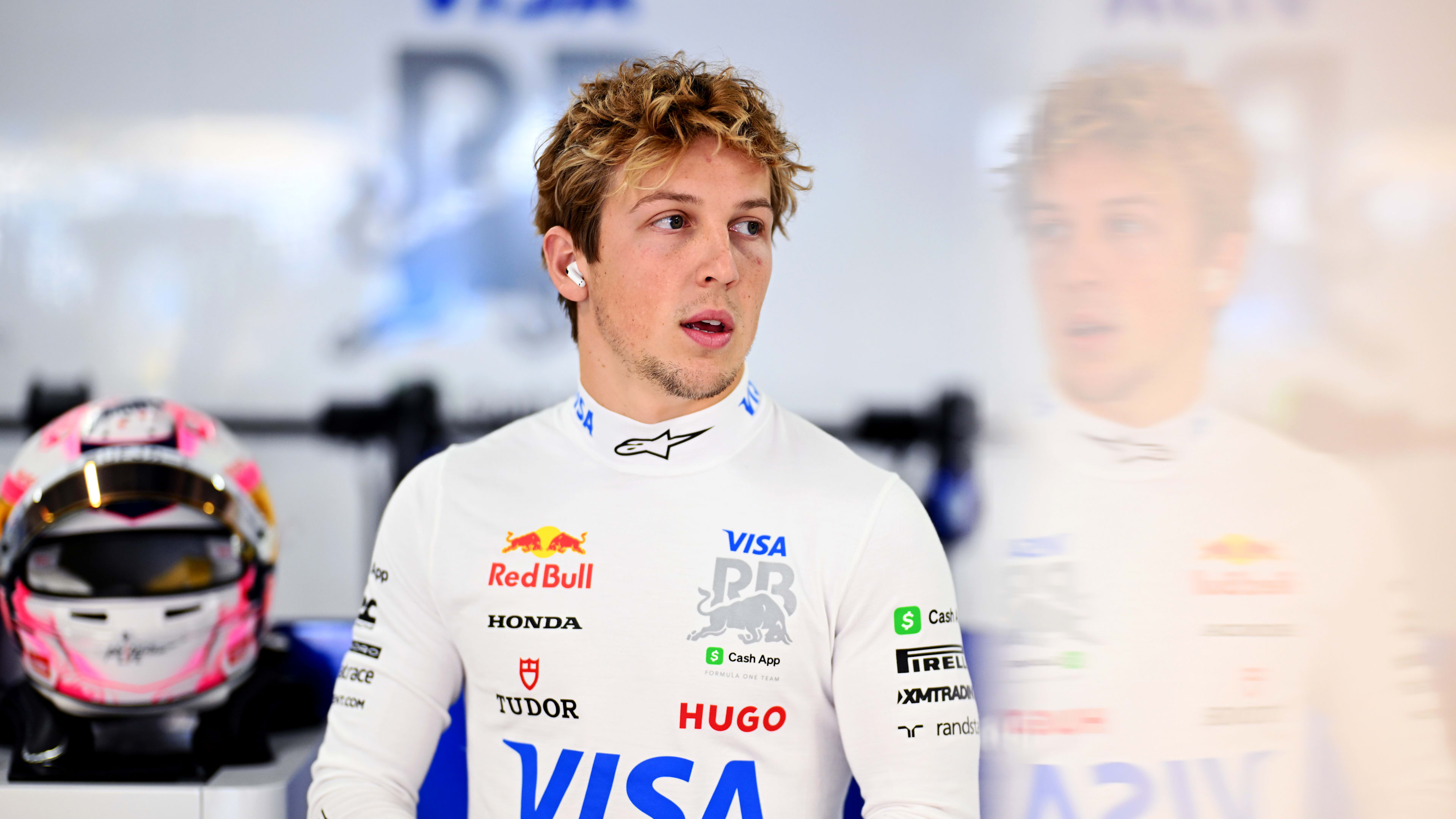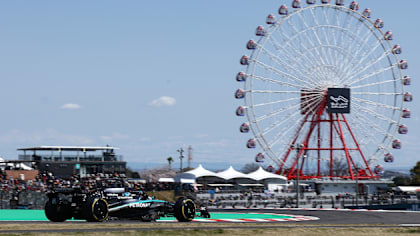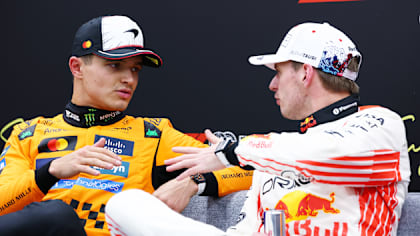)
Feature
‘It’s the fastest ambulance in the world’ – Inside the Medical Car’s crucial role in F1

Share
)
When the often frantic first lap of a Grand Prix has been completed, there is just one car on the grid that brings relief when it peels back into the pits having not been needed. That vehicle is of course the Medical Car, which follows behind the pack on Lap 1 to be quick on the scene in the case of any incidents.
A familiar sight alongside the Safety Car, the Medical Car is on hand to get Medical Delegate Dr Ian Roberts and a local doctor to the location of an accident as quickly and safely as possible, and driving duties are shared by Bruno Correia and Karl Reindler.
TIMELINE: The 50-year history of the Safety Car's evolution in Formula 1
The vehicle, meanwhile, is provided by either Aston Martin or Mercedes, with the former coming onboard in 2021 alongside their return to the sport as a constructor. During a chat with F1.com, Dr Roberts acknowledges that the car is “absolutely vital” in enabling him to do his job.
“The car needs to get us from our standby position to the incident in a safe and efficient way, not necessarily fast, but that's part of it,” the Briton explains. “The thing is, we don't want to be a part of the incident, and we don't want to create one, so that's the whole reason for having a professional driver to do that job for us.”

The Medical Car follows behind the rest of the field on Lap 1 of a race
What does the Medical Car carry onboard?
Just one crucial aspect of the vehicle is carrying the equipment needed in the event of an accident, which Dr Roberts describes as “essentially a graded response.”
“In my overall I carry very few things which are there for an immediate intervention and, over time, I found that that really covers 98% of the things we need to deal with,” he says.
“At my feet, I have a small bag with the next stage of equipment and then, in the trunk, we carry a full resuscitation bag, ancillary equipment, monitoring, burns dressings, electrical gloves – should we need them, should the car be dangerous in that respect.
“[We carry] fire extinguishers in case we need to extinguish people – because we're not firefighting on the car, it's just for protecting and preserving life – and we carry a cutter for the halo.
“And then on top of all of that, we have the local doctor’s equipment, so they carry their trauma bag, their trauma equipment, so it's really a first intervention set-up. And then, of course, we call upon further medical cars, ambulances and extrication vehicles that are located around the track.”
With so many factors to consider in ensuring that the Medical Car is fit for purpose, Dr Roberts has been impressed by Aston Martin’s contribution since joining in 2021, with the manufacturer providing the powerful DBX707 for the role.

Aston Martin provide the DBX707 to act as the Medical Car
“The relationship’s been absolutely brilliant,” he reflects. “When they first came on board, they took the project very seriously right from the start. [They] assigned a couple of guys to work with us, see what we were doing already, and then [to see] how they then develop their car, because initially they brought in the DBX, which, of course, is quite an unlikely intervention vehicle.
“But they developed that further for the track and upgrades, etc. The current car performs brilliantly. The team that comes along with the car, again, can't fault them. They're not only a decent bunch of guys, they're also very involved with us in terms of making sure that we get what we need from them.
READ MORE: Who is Andy Cowell? All you need to know about Aston Martin’s new F1 team boss
“They’ve been great. They take on board what we say, any feedback, and they've supported us, not just with the car, but also with the whole Medical Car operation, really. So, yeah, couldn't ask for a better bunch of guys.”
Another vital aspect of that operation is the driver, as Dr Roberts explains: “I used to work with Alan van der Merwe for many years, but Alan went on to other projects, and in his place we then had Bruno and Karl, both professional drivers in their own right.
“They haven't had any experience of a Medical Car before, they started with us here, but they've soon come on board really, really quickly. They're not medically trained, but they do form part of the medical response in supporting me once we get to the incident, so they deliver the medical resources to the incident in an efficient way, and they allow myself and the local doctor to get on with the job of looking after the driver.”

The driver of the Medical Car plays a vital role in delivering the medical resources to the scene of an incident
What it’s like to drive the ‘dream’ Aston Martin
As mentioned by Dr Roberts, one of those drivers is Correia, who brings with him a background as a professional racer. The Portuguese driver’s journey began with karting in the 1990s before progressing to single seaters, where he won championships including the Spanish Formula Renault Championship.
It was at this point, Correia says, that he “stopped with the dream of becoming a professional racing driver” and, “by luck”, was given the opportunity to drive the Safety Car in the World Touring Car Championship in 2009.
READ MORE: 5 things to be excited about as F1 gears up for the 2025 season
Since then he has continued in this role across different categories – including Formula E – while he first got behind the wheel of F1’s Medical Car after standing in when former driver van der Merwe tested positive for COVID-19 at the 2021 Turkish Grand Prix.
This means that Correia ultimately reached Formula 1 in a capacity that he perhaps did not initially expect during his earlier career. When asked if racing in F1 had been his dream back then, the 47-year-old answers: “It's always a kid's dream, but I was not 100% fully focused only on this pathway.
“My dream was to be involved somehow in motorsport as a driver. Everyone knows that, arriving in F1, it's quite an achievement. Coming from Portugal, it's even a bigger achievement, because we are a small country, so it's always a bit more difficult to find the means to reach such a high level, and it's an expensive sport, the most expensive sport in the world.

Bruno Correia was a professional racer before becoming a Safety Car and Medical Car driver
“It's always a dream to arrive at this level being a professional racing driver, and if it's in F1 – better. But I always had that clear, that it will be quite difficult, so to find a different way to be a professional driver was probably more realistic at that time. I never thought that I would be sitting on the grid at the start of a race! [It’s an] achievement!”
While he may not be at the wheel of a Formula 1 car, Correia is full of praise for the performance of the Aston Martin DBX707, a vehicle he labels as “absolutely astonishing”.
F1 EXPLAINS: The secrets of the Safety Car with driver Bernd Maylander
“It’s like a dream car,” he continues. “The DBX707, it's a quite impressive machine. I mean, we are talking an SUV, the fastest SUV in the world, 3.1 seconds [it goes from] zero to 60 [mph]. It’s a quite powerful car. On the other hand, what really impressed me is the handling of it.
“You never expect an SUV, a big car with that amount of power, to handle the way it does. It's super comfortable for our duty.
“It has the room that we need to bring the doctors and also the medical equipment, which is a lot, and also always a spare place for a driver, in case you need to pick him up on the track. [I’m] really proud to be involved with Aston Martin, also with Mercedes, obviously, but the car itself, it's unbelievable, and it sounds amazing.”

The Aston Martin DBX707 has earned praise from Correia and Dr Roberts
Recognition after Grosjean’s horror crash
Like Correia, Dr Roberts comes to his role with a background that helps him to be ready for any eventuality. After working trackside at Silverstone and subsequently becoming Chief Medical Officer for the circuit and the British Grand Prix, he began working with the FIA in 2013 as Medical Rescue Coordinator and went on to take the position of Medical Delegate.
Having now held the job for many years, it has brought with it some good and bad moments, with Dr Roberts acknowledging that the latter – such as incidents where a driver has been seriously injured or sadly lost their life – “always stick out in your mind”.
READ MORE: All the 2025 F1 driver numbers confirmed in full
Perhaps the most famous incident in recent memory that required the intervention of the Medical Car was the fiery crash suffered by Romain Grosjean at the 2020 Bahrain Grand Prix, from which the Frenchman miraculously walked away with only minor injuries.
Dr Roberts received an FIA President Award in acknowledgement of his reaction to the accident, as well as being praised by Grosjean himself. When asked if it was a nice feeling to be recognised for an incident where the outcome was fortunately a positive one, he responds: “Oh, for sure, yes.
“That was great because, arriving at that scene, it was devastating, and obviously we thought that things were going to be bad. But it was also a great demonstration of the way safety has moved on and that, thank goodness, everything came together on that day.”
2020 Bahrain Grand Prix: Grosjean escapes huge crash and fire at race start
Correia also acknowledges that Grosjean’s crash highlights the importance of the Medical Car being on the scene as quickly as possible, adding: “We have also had a lot of times [where there have been] crashes at the start, not only in F1 but also in F2 and F3. So it's really important that either the drivers or the people surrounding the situation feel that they are in good hands, and we can actually make the situation the least painful as possible.”
Continuing the legacy of safety in motorsport
As Dr Roberts mentioned, the Grosjean incident shone a light on the continued development of safety measures in Formula 1, a legacy of the work carried out by many over the years including the late Dr Sid Watkins, who previously served as the sport’s Medical Delegate from 1978 until 2004.
F1 ROOKIES QUIZ: How much do you know about the new drivers set to hit the Grand Prix grid in 2025?
“It's very important to recognise that in the era before Sid's involvement, there were some very extreme incidents, and drivers were losing their lives every race, almost,” Dr Roberts concedes. “To say that there were no safety measures and there was nothing in place is very unfair to the people that came before, and there were many innovations going on.
“The issue was that they were very disjointed, and for some races things would be good and for others were non-existent. Sid certainly found when he went to some races that, for example, the medical centres were really not up to scratch, so Sid’s contribution comes in two-fold, really.
“He pulled those innovations together and then went forward with the research, pushing the FIA to invest time and money into improving safety measures across the board – not just Formula 1. Formula 1 is very high profile and, of course, anything that happens in Formula 1 also benefits other series, and that's where things like the FIA Institute [and] setting up the medical commission all came in, brought all these things together and got people thinking about safety.”

Dr Roberts and former Medical Car driver Alan van der Merwe were recognised for how they came to the aid of Romain Grosjean after his crash in the 2020 Bahrain Grand Prix
The roles of Correia and Dr Roberts are both pivotal in continuing to ensure that race weekends run as safely as possible, a responsibility that Correia does not take lightly when he drives what he calls “the fastest ambulance in the world”.
“I think it's a quite demanding job, to be sharp all the time,” he explains. “It's quite difficult with all the traveling and all these movements, jet lag and so on. But again, we love what we do, and it's crazy. We are just mental people at the end!
“It's, for me, an honour to be involved at such a high level and [to have] this responsibility, which is also a big responsibility, a lot of exposure. Let's make sure that we all come [home] safe after a nice racing weekend.”
Dr Roberts agrees that, as much as he enjoys his job, the best outcome of a weekend is where he ultimately has very little to do.
“The best races or the best weekends are where, after we've done all the preparation, we do absolutely nothing – everybody has a fantastic time, and we go home at the end of it having done nothing,” he smiles.

RACE TICKETS - JAPAN
Don't miss your chance to experience Formula 1 at the epic figure-of-eight Suzuka Circuit...
Share
YOU MIGHT ALSO LIKE
News Norris admits McLaren ‘just didn’t have enough’ after losing pole in Japan as he predicts ‘good fight’ from Verstappen

Video HIGHLIGHTS: Catch the action from FP3 in Japan as Norris and McLaren head the pack
FeatureF1 Unlocked PRACTICE DEBRIEF: Who’s on top and who’s got work to do after a red flag-filled Friday in Suzuka?
News FIA post-Qualifying press conference – Japan



